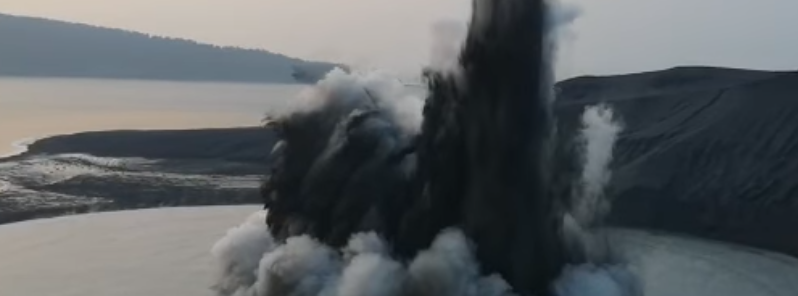Very close view of Surtseyan eruption at Anak Krakatau, Indonesia

A group of tourists visited Anak Krakatau on September 18, 2019, and managed to capture a surprising explosion from a very close distance.
The activity at the volcano has not changed over the past weeks, with intermittent phreatic or phreatomagmatic explosions in the crater lake, Volcano Discovery reports.
Krakatau's seismic network recorded five eruptive events from September 9 to 15, according to PVMBG. A webcam at the summit recorded diffuse white plumes rising 150 m (492 feet) from the bottom of the crater, and dense gray-and-white ash plumes rising 300 m (984 feet).
The Alert Level remains at 2 (on a scale of 1-4), and the public is warned to remain outside of the 2-km-radius (1.2 miles) hazard zone from the crater.
.png)
.png)
A violent phreatomagmatic eruption took place at the volcano at 02:09 UTC on June 25, 2019, and was also recorded on video:


Geological summary
The renowned volcano Krakatau (frequently misstated as Krakatoa) lies in the Sunda Strait between Java and Sumatra. The collapse of the ancestral Krakatau edifice, perhaps in 416 CE, formed a 7-km-wide (4.3 miles) caldera.
Remnants of this ancestral volcano are preserved in Verlaten and Lang Islands; subsequently Rakata, Danan and Perbuwatan volcanoes were formed, coalescing to create the pre-1883 Krakatau Island. Caldera collapse during the catastrophic 1883 eruption destroyed Danan and Perbuwatan volcanoes, and left only a remnant of Rakata volcano.
This eruption, the 2nd largest in Indonesia during historical time, caused more than 36 000 fatalities, most as a result of devastating tsunamis that swept the adjacent coastlines of Sumatra and Java. Pyroclastic surges traveled 40 km (25 miles) across the Sunda Strait and reached the Sumatra coast.
After a quiescence of less than a half century, the post-collapse cone of Anak Krakatau (Child of Krakatau) was constructed within the 1883 caldera at a point between the former cones of Danan and Perbuwatan. Anak Krakatau has been the site of frequent eruptions since 1927. (GVP)
Featured image credit: Sylvie Loison, John Van Marcke

Commenting rules and guidelines
We value the thoughts and opinions of our readers and welcome healthy discussions on our website. In order to maintain a respectful and positive community, we ask that all commenters follow these rules.